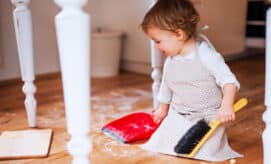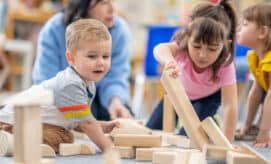Many early learning professionals know that transitions can be one of the most challenging parts of the day in an early learning environment. Young children often struggle as they move from one activity to the next and educators can feel overwhelmed by the number of tasks that need to get completed.
We are sharing a few tips to help you reflect on the use of transitions in your classroom and to consider potential changes to relieve some of the transition-related stress that you might be feeling.
Think About Your Instruction
As we get ready to transition to nap time, there are several items that need to be completed. We often ask children to take their shoes off, put them away, and get their cot ready for resting. Some days this goes smoothly, while other days the nap transition is a challenge. While it might feel frustrating when children are not listening, take a moment to reflect on how much you are asking to make sure that children are not overwhelmed by too many requests.
Start by walking children through the plan and expectations by saying something like, “We’re getting ready for a nap now. We need to put our shoes away and find our beds so that we can rest.” For younger toddlers and preschoolers, keep it simple with one-step instructions. Begin with the first task, such as “let’s find your shoes.” Allow the children a chance to complete the first step of the task before moving on, while offering support to children who need help. Then move into the next step while also acknowledging the child’s success, “We found them! Let’s find your cubby to put them away.” Older children will be able to independently complete multiple steps, but might also need gentle reminders such as, “It looks like you haven’t found your sheets yet. We’re working on getting our beds ready for resting.”
Support children each step of the way, and try not to get frustrated when they get lost. Transitions often feel stressful because there are several tasks that need to get done. Offering children a chance to help empowers them to take responsibility for their own items, and helps everyone to move through the transition more smoothly.
Set The Room Up for Success
When children wake up from their naps or come back to the classroom after playing outside, it is a good idea to have activities for them set up and ready to play. It gives children something they can immediately work with, avoiding the feeling of chaos that can occur when children are not sure what to do. Simple activities that welcome children into a new space include putting some blocks out a table as an invitation to build or placing paper and drawing utensils on the table to invite children to create.
Some teachers create “go boxes” or “rainy day boxes” by filling boxes with all of the items needed for a simple activity that will be ready-to-use when needed. Here are some ideas for simple boxes, using items that you probably already have handy in your classroom:
-
Invitation to cut (for preschoolers): Put pieces of scrap paper, plastic bowls, and scissors in a box for a simple cutting activity. Children can practice cutting the scraps of paper and small pieces can be placed into the plastic bowls when they are done cutting to keep the room tidy.
-
Play doh or clay (for toddlers, preschoolers, and pre-k): Have some play doh or clay stored in a box along with wooden utensils, cookie cutters, and other items that children can use to cut, slide, and mold the play doh as they create.
-
Self Portraits (for preschoolers and pre-k): Place small mirrors in a box with pencils and paper so that children can look at their faces and draw pictures of themselves and their friends.
-
Writing Journal (for older preschoolers and pre-k): Some teachers keep journals handy that children can draw and write in when there is free time. Each child can have a personal notebook that they can revisit to write notes and draw pictures. If you start the notebooks early in the year, children can take them home at the end of the year and reflect back on the work they’ve done!
Evaluate the Flow of Your Classroom
Sometimes transitions can feel chaotic when the flow of the classroom is challenging for children to navigate. This is especially true for toddlers and younger preschoolers who are easily distracted and can quickly get off track. Think about the flow of your space as children move from one item to the next.
For example, if children need to get their jackets before they go outside, it might make sense for jackets to be located close to the door. Or, if children are moving from outside play to go in for a nap, it might be best to avoid putting nap mats directly next to the door where children will have to walk by their friend’s beds and avoid stepping on them.
Keep it Consistent
Children do well when they can anticipate the flow of the day and know what is coming next. Although there will be days when the schedule fluctuates, try your best to keep the classroom routine as consistent as possible. The daily schedule can be posted throughout the classroom for parents to view so that everyone is on the same page. If there are going to be any changes to the schedule, ensure that you talk about these changes with the children for several days leading up to the event. This will set children up for success, and help them stay calm. When children are unsure about what is happening or what is expected of them, they will often feel anxious and uncomfortable.
Stay Calm
While it may be challenging, do your best to stay as calm as possible even when you feel overwhelmed. Take a few deep breaths in moments of stress, and try not to let negative feelings get the best of your. Children can sense when you are upset, and will feed off of your energy. The more you are able to keep your cool, the easier the transition will be.





